
Female homosexuality is known as lesbianism (less often sapphism, tribadism). The term comes from the name of the Greek island of Lesbos, where the ancient Greek poetess Sappho was born and lived, in the verses of which there are hints of love between women. Compared to male homosexuality, female homosexuality has been little studied. Same-sex relationships between women are inherently less destructive and entail far fewer problems, and therefore there is no particular need to direct research efforts in this area. Nevertheless, from the little that is known about women entering into same-sex relationships, there is by no means a rainbow-colored picture. Homosexual and bisexual women are more likely to suffer psychiatric disorders and demonstrate a number of issues related to their lifestyle: short-lived relationships, alcohol abuse, tobacco and drugs, partner violence and an increased risk of STD infection. Older lesbians, more than their heterosexual peers, subject to risk of developing obesity and breast cancer, и more often report the presence of arthritis, asthma, heart attack, stroke, an increased number of chronic diseases and poor health in general.
Etiology
Lesbianism by D. Nicolosi
Lesbianism by A. Sigler-Smaltz
Lesbianism by E. Bergler
Statistics
HIV and STDs
Mental disorders and addictions
Violence
Cancer and obesity
Possibility of change
Etiology
It is necessary to distinguish between homosexual behavior and homosexual attraction, since one does not necessarily accompany the other. Homosexual emotional craving always a symptom of mental pathology, while homosexual behavior not necessarily accompanied by homosexual attraction and, therefore, does not allow the conclusion about the presence of psychopathology in the practitioner. The reasons leading a mentally healthy person to have sexual activities with their gender are extremely varied. They can wear substitute if the partner of the opposite sex is inaccessible, to be done out of curiosity, selfish interestsexcessive lust and sexual promiscuitybut at the same time be deprived of any homosexual experiences and emotions. Some teenage girls, under the influence of the media, now decide that they are lesbians because they have never experienced emotional closeness with men and feel more comfortable in dealing with women. This is undoubtedly a very hasty and erroneous self-sentence, since any heterosexual woman has a greater sense of trust, intimacy and understanding with her friends than with men. In addition, it has now become fashionable among young people to declare their “bisexuality”, and some girls are experimenting with their gender more because of the cultural trend. Such episodes are not of interest to this article: it will focus on homosexuality, characterized by persistent and difficult to overcome, and sometimes even compulsive attraction to one's sex. The presence of such attraction in a person indicates that in the process of his psychosexual development an event occurred that disrupted his normal course and prevented the achievement of the final stage - heterosexuality. Thus, libidinized homosexual feelings are a symptom of emotional immaturity and neurosis.
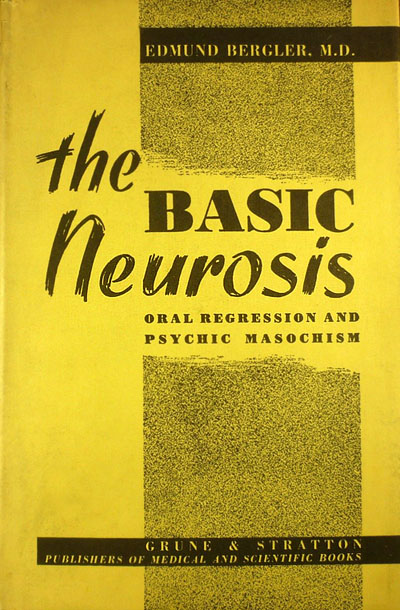
We will make a small digression to better understand what constitutes neurosis from the perspective of deep psychology. Edmund Bergler in his work "The Basic Neurosis" describes the neurosis as “an anachronistic (i.e., not relevant to the present) disease unconscious", Which is based on a conflict of infantile desires, fear, guilt and action protective mechanisms... In other words, we are talking about a relatively moderate mental disorder, manifested in maladaptive and self-destructive tendencies, but without losing touch with reality (although its perception can be significantly distorted). Clinical experience proves that neurosis only progresses over the years.
The cause of neurosis is external or internal stresses that cause psychological trauma, which is subsequently forced out into the unconscious. In the case of same-sex attraction, this can be molestation, imaginary or real rejection by peers or parents, inability to establish close relationships with members of the same sex. The patient is not aware of the essence of the underlying conflict, and only an unconscious defense against the repressed problem is visible on the surface. The neurotic is constantly on the lookout for a person or situations that allow re-experiencing of his neurotic pattern. He can be compared to a man who carries a gramophone record with him everywhere and is constantly looking for a turntable on which he can play his only record - his basic unconscious neurotic tendency.
It should be noted that practically all people have neurotic tendencies, but not all of them are enlarged to such an extent that a neurosis occurs. This is a problem of quantity, not quality (although, as Hegel noted, the moment may come when quantity turns into quality). The decisive difference between a normal and a neurotic person is that the former has overcome his childhood conflicts to a greater extent and has a more objective view of reality, while the latter abuses reality to unconsciously repeat his childhood conflicts.
Lesbianism by D. Nicolosi
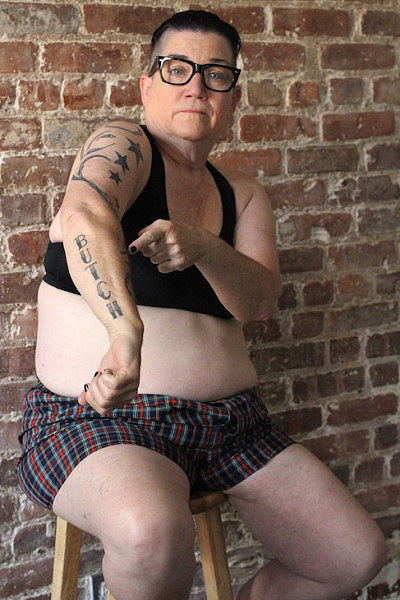
As the founder of the National Association for the Study of Homosexuality explains, Dr. Joseph Nicolosi, the main conflict underlying lesbianism is the girl's unconscious rejection of her femininity. Often, this rejection is based on psychological trauma, which prevents the establishment of a connection with the mother during a period critical for the development of feminine identity. Even if the girl does not exhibit overt masculine behavior, well, she will still have symptoms of gender conflict. In other cases, girls who turn to lesbianism subconsciously decide that being feminine is undesirable or unsafe. Some mothers unknowingly present their daughters with an unattractive image of femininity, presenting a weak or negative object for identification. By rejecting mothers as an object of identification, girls also reject the femininity that their mothers personify. For example, observing a passive subordinate mother, submissively enduring humiliation and violence from a man, a girl subconsciously decides: "if this means being a woman, then I do not want to be one." Sometimes a similar reaction is triggered by sexual abuse by a man at an early age. From the girl's point of view, her femininity somehow provokes sexual violence and, therefore, in order to protect herself, the girl considers it necessary to abandon the “problematic” feminine part of herself. Women who are sexually abused or raped during childhood and adolescence are almost impossible to trust in men. Therefore, they can turn to women for satisfaction of the need for love and sexual desires.
Often, such women appropriate masculine manners and even appearance. This is a primitive psychological survival mechanism, equivalent to the statement: “If someone offends me, I will become like him - so that I will not be hurt. I will be among those who rule. " Many girls with gender disorder are preoccupied with strength, aggression, and fantasies in which they play a protective role. In adulthood, such women may practice sadomasochism, domination, or the "leather" theme. These practices release the subconscious attraction-repulsion conflict in gender matters. The girl who could not identify with her mother suppresses anger against her, because, on the one hand, she wants her, and on the other, she is wounded by her.
Some lesbians suffer not so much from failure in the identification process, but from an unmet need for maternal care. Such women have an unconscious need to restore a fragile connection with their mother, the personification of which they find in another woman. The attractiveness of lesbian relationships lies in the fact that a woman is “filled” and connected with the part of herself that she was forced to abandon - her femininity. She kind of borrows it from another woman, but such a neurotic way of solving the problem does not bring healing to the soul. An alliance with another woman gives only the illusion of integrity, which must be constantly supported by complex mechanisms of self-deception and distortion of reality.
Lesbianism by A. Sigler-Smaltz
Therapist Andria Sigler-Smaltz, a former lesbian, currently married, describes the the nature of lesbian relationships.
Lesbian prefers people of her own sex to satisfy her unconscious aspirations and is afraid of intimate communication with the opposite sex. In lesbianism, a woman is “stuck” in development and therefore cannot advance towards healthy heterosexuality. When exactly and how the violation of healthy development occurs, determines the degree of its problems with gender identity.
The driving force in lesbian relationships is the lack of emotional connection and concern on the part of their gender, which, as a rule, are not as sexualized as in male homosexuality. One client, realizing that her lesbian relationships recreate her need for maternal love, explained to me:
“When I meet a woman whom I am attracted to, something inside me says: “Will you be my mommy?” This is an irresistible strong feeling with which I can not do anything. Suddenly I feel small. "I want her to notice me, I want to be special for her, and this desire captures my mind."

Some lesbians experience negative feelings and internal conflicts with men, which contributes to their inability to accept heterosexuality. Moreover, some of them firmly identify with radical feminism, where women are seen as gifted and desirable, while men are seen as inferior, sex addicted and somewhat useless. It is by no means uncommon that women who have been involved in a lesbian lifestyle for a long time begin to experience a growing disgust for heterosexual relationships.
The main fundamental difference between men and women is that sex and sexual attraction are not necessarily key components of lesbian relationships. For homosexual women, “emotional attraction” plays a more important role than sexual attraction. Cases in which sex is a critical component are related to the fact that it symbolizes emotional intimacy.
Lesbians often experience the feeling "I can not live without you" in relation to each other. At first glance, there is potential for particularly strong attachment in these relationships, but a closer look reveals a behavior that indicates a fragile bond full of fear and anxiety. Key conflicts appear in recurring themes related to identity formation. For example, we see the fear of being abandoned and / or absorbed, the struggle for control and power (or anarchy), as well as the desire to merge with another person to get a sense of security and significance.
Relations between women gravitate more toward social exclusivity than inclusiveness, and it is not unusual for a lesbian couple to gradually reduce contact with family members or old friends. Such distancing provides control over the partner, preventing its autonomy, and serves as protection against alleged threats to their fragile alliance.
Despite the fact that lesbian partnerships are usually longer than male ones, they are often filled with emotional tension and hold on to the “paste” of jealousy *, over-possessiveness and various manipulations. In these respects, emotional ups are very high, and conflicts are extremely aggravated. The excessiveness of spending time together, frequent phone calls, disproportionate giving of cards or gifts, hasty moving under one roof and combining finances - these are some of the ways to protect against autonomy. In such relationships, we see a counterfeit of healthy attachment - emotional dependence and extreme interweaving.
* Pathological jealousy characteristic of lesbians was noted in the classic Kraft-Ebbing work of 1886 of the year "Sexual psychopathy": “This forbidden friendship flourishes especially in women's prisons and is accompanied by both wild jealousy and passionate passion. As soon as the prisoner sees that another prisoner smiled at her lover, a scene of extreme jealousy arises up to the fight. " It is a confirms and the warden of the modern women's prison: “For such couples you need an eye and an eye, because the scandals between them are terrible: you didn’t look, you didn’t smile, and that’s all - there were fights and fights. They also parted in such a way that everyone is in the know - with loud scandals and sharing of their simple property. ” And according to another article about women's prison: "The coolest, bloody showdowns, sometimes fatal, occur precisely in the female colonies of the post-Soviet space and mainly because of the jealousy of the coble (active lesbians)."
Lesbianism by E. Bergler

The genesis of female homosexuality is identical to the male: an unresolved masochistic conflict with the mother of early infancy. In the oral phase of development (the first 1,5 years of life), a novice lesbian goes through a series of difficult ups and downs with her mother, which impede the successful completion of this phase. The peculiarity of the clinical lesbian conflict is that it represents an unconscious three-layer structure: the masochistic “gathering of injustices”, which is covered by pseudo-hatred, which is covered by exaggerated pseudo-love for the representative of the infantile image of the mother (neurotics are only capable of ersatz emotions and pseudo-aggression).
Lesbian is a neurotic with a triad of unconscious concealment, leading to a rather tragicomic quid pro quo, a joke on a naive observer. First, lesbianism, paradoxically, is not erotic, but aggressive Conflict: The Basis mental masochism oral-regressed neurotic is an unresolved aggressive conflict that returns as a boomerang due to guilt and only secondarily libidinized. Secondly, under the guise of a “husband and wife” relationship, neurotically charged relationships between child and mother. Thirdly, lesbianism gives the impression of a biological fact; a naive observer is blinded by their conscious pleasure, while underneath is a treatable neurosis.
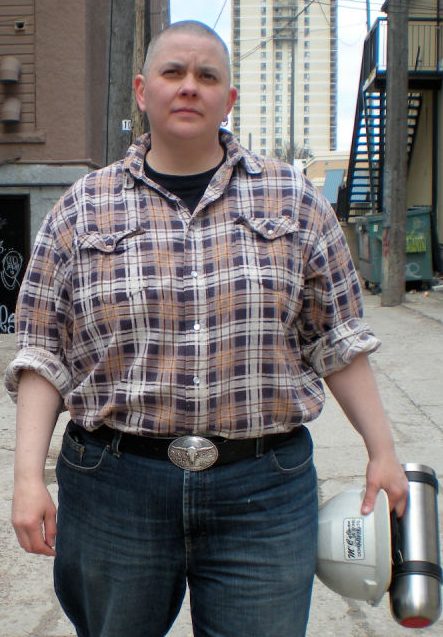
The outside world, in its ignorance, considers lesbians courageous women. However, not every courageous woman is homosexual. On the other hand, an outwardly courageous lesbian imitating men in clothing, behavior and relationships only shows camouflage that hides her real conflict. The confused observer is unable to explain the “passive” lesbian or the fact that lesbian sexual practices, demonstrating infantile direction, are concentrated mainly around cunnilingus and breast sucking, and mutual masturbation by dildos is concentrated around the clitoris, which is unconsciously identified with the nipple.
My 30 years of clinical experience has shown that lesbianism has five levels:
1) masochistic affection for the mother;
2) veto of inner conscience prohibiting "pleasure from displeasure";
3) the first defense is pseudo-hatred;
4) a repeated veto of inner conscience prohibiting hatred of any kind towards the mother;
5) The second defense is pseudo-love.
Thus, lesbianism is not “female love for a woman”, but the pseudo-love of a masochistic woman who created an internal alibi that she does not consciously understand.
This protective structure in lesbianism explains:
a. Why lesbians are characterized by tremendous tension and pathological jealousy. In inner reality, this type of jealousy is nothing more than a source for the masochistic “gathering of injustices”.
b. Why violent hatred, sometimes expressed in physical attacks, is so subtly hidden in homosexual relationships. The pseudo-love layer (fifth layer) is only a protection covering pseudo-aggression.
a. Why lesbians resort to oedipal camouflage (farce of husband and wife) - it disguises masochistic relations of mother and child, rooted in pre-oedipal conflicts, heavily burdened with guilt.
Mr. Why is it useless to expect satisfactory human relations within the framework of lesbianism. A lesbian unconsciously seeks constant masochistic pleasure, therefore she is incapable of conscious happiness.
The narcissistic lesbian substructure also explains why the infantile conflict with the mother never goes away. Under normal development, the conflict with the mother is resolved by the girl through splitting: the old “hatred” remains with the mother, the component of “love” is shifted to the father, and instead of the duality “baby-mother” (preedipal phase) a triangular oedipal situation “child-mother-father” arises. The future lesbian tries to do the same, only to be thrown back into the original conflict. The oedipal “solution” (itself a transitional phase that the child abandons in the course of his normal development) is that lesbians use the husband-wife (father-mother) disguise as a protective cover.
It is necessary to distinguish between two forms of unconscious identification: “leading” (leading) and “leading” (misleading). The first represents the suppressed desires of the individual, crystallized into the end result of the infantile conflict, and the second refers to identification with people who are chosen to deny and reject the rebukes of inner conscience against these neurotic desires. The “leading” identification of an active type of lesbian refers to preedipal mothers and "leading" to the oedipal father. In the passive type, “leading” identification refers to the child, and “leading” to oedipal mothers.
All of the above, of course, is justified by clinical evidence, described in detail in the books of E. Bergler.

Statistics
On the latest data American Medical Association (AMA) lesbians more often than heterosexual women report psychological distress, poor health, multiple chronic problems, alcohol abuse, and heavy smoking. Other sources add to this list increased risk breast cancer, depression, anxiety, cardiovascular disease, gynecological cancer, obesity, intravenous drug administration, as well as all the risks of unprotected sex with numerous men.
HIV and STDs
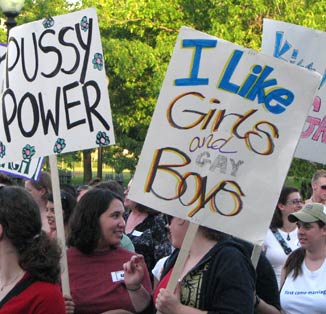
A number of studies [1, 2, 3], established a reliable correlation between homosexual behavior in both sexes and the absence of a father in early childhood, and more so in girls than boys [1, 2]. One possible explanation suggests that the presence (or absence) of the father in the household is perceived as an indicator of the stability and reliability of relationships with men. According to another explanation, girls who survived the divorce of their parents in early childhood begin to have sex earlier and have more short-term sexual partners.
Studies have shown that liberated sexual behavior positively correlates with homosexuality. Sexually unrestrained women have an increased number of sexual partners, many of whom may statistically be women. According to recent researchWomen with many same-sex sexual partners have even more partners of the opposite sex.
According to According to The U.S. Centers for Disease Control Center (CDC) before 97% of lesbians had sex with men (28% in the last year), with 86% practicing vaginal and 48% anal intercourse. It was establishedthat women who have sex with other women (WSW) are more likely than heterosexual women to have anal or oral sex with a partner of the opposite sex, and the likelihood that they had more than 50 sexual partners above by 350%. The more partners, the higher the risk of infection. Overall, WSW more inclined to sexual activity with homosexual men (partly due to the fact that they feel more confident with “like-minded people”), which is even more increases their risk infection with HIV, hepatitis C and other STDs characteristic of MSM (men who have sex with men).
Compared to 32% heterosexual women, 44% WSW сообщили About the previous diagnosis of one or more STDs. The most common STDs transmitted between women include bacterial vaginosis, chlamydia, genital herpes and the human papillomavirus, which is pathogen cervical cancer.
Over the past two decades, the lesbian community became more sexualized. Erotic magazines, sex toy stores, and porn film companies aimed at and run by lesbians proliferated. Lesbian clubs advertise “I Love Pussy” nights and proudly flaunt the “activity” in bathroom stalls. Lesbian BDSM organizations exist in most major cities in the United States, and polyamory is also becoming more common. Some lesbians have recently begun to imitate the sexual practices of MSM, including fisting, rimming (35%), urolagnia and anal injection of objects (25%) This behavior is certainly associated with a serious health risk.
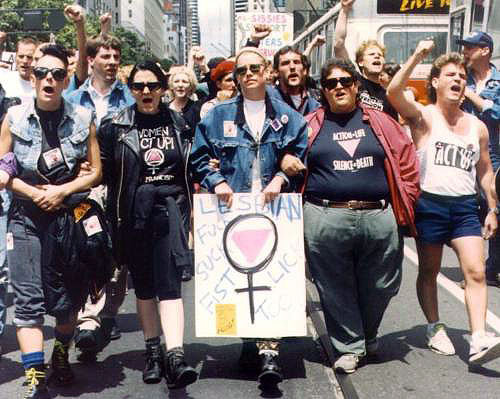
Mental disorders and addictions
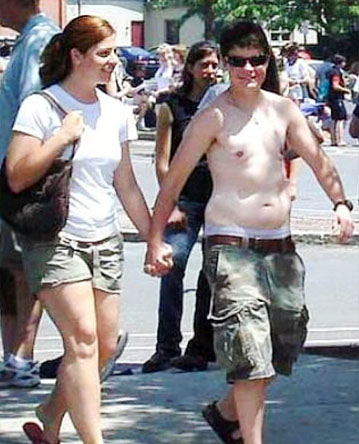
Many sources [1, 2, 3, 4, 5, 6, 7, 8] note that CSF reported 2-3 times more often about depression, anxiety and suicidal thoughts. The condition of those women who are identified as “bisexual” is especially deplorable. Moreover, among WSW there is a tendency to postpone and avoid seeking medical help. Another negative trend is that some women, initially identified as lesbians, subsequently change their identity to “transgender”, which puts them at risk of irreversible damage from taking male hormones, disfiguring surgeries and further psychological suffering.
According to According to The American Psychiatric Association, WSW is 3 times more likely to suffer from substance use disorders and is more likely to abuse alcohol and hard drugs. As before, these sad statistics are dominated by “bisexual” women. US Department of Health (HHS) Women's Health confirms:
"Drunkenness and drug addiction appear to be more common among lesbians (especially young women) than among heterosexual women ... Bisexual women are more likely than others to have injected drugs and are at a higher risk of sexually transmitted infections."
Research in the state of California has demonstrated that the risk of alcohol dependence in CSW is increased by 4 times, drug - by 3,5 times, and any other disorder associated with the use of psychoactive substances - by 3,4 times.
Violence
Large study showed that lesbians and bisexual women in childhood experienced a disproportionate “Prevailing and ongoing violence”. For many lesbians, violence does not end in childhood and is now continuing on the part of the partner. Lesbian couples more oftenthan homosexual men are victims and initiators of violence.
An APA study found that 47,5% of lesbians have ever experienced physical abuse from a partner. Similar data presented CDC - 40,4% of lesbians were physically abused by a partner; in 29,4%, the violence was serious: beating, cauterizing or or hitting something hard.
The Journal of Family Research сообщилthat 70,2% of lesbians have experienced psychological abuse over the past year. Another study has shownthat 69% of women involved in same-sex relationships report verbal aggression, and 77,5% of controlling behavior on the part of the partner. By According to A recent CDC review, on average 63,5% of lesbians experienced psychological aggression from a partner, most often manifested in isolation from family and friends, humiliation, insults and assurances that no one else needed them.
Lie and colleagues notethat aggression in lesbian relations is most often of a mutual nature. In their sample, 23,1% of lesbians reported forced sex from their current partner, and 9,4% from their former partner. In addition, 55.1% reported verbal and emotional aggression. In another Research it was found that compared to 17,8% of heterosexual women, 30,6% of lesbians had sex against their will, and according to Waldner-Haugrud (1997(1)) 50% of lesbians experienced violent penetration by their partner.
В article 1994 of the year in the journal “Journal of Interpersonal Violence” addressed the problems of conflict and violence in female homosexual partnerships. Researchers found that 31% of respondents reported having experienced at least one episode of physical abuse by a partner. According to the data Nichols (2000), 54% of homosexual women noted that they experienced 10 and more episodes of violence by partners, 74% indicated 6 – 10 episodes.
According to a study by the government of Canada:
"... spousal violence occurred twice as often among homosexual couples as compared with heterosexual ones: 15% and 7%, respectively" (Measuring Violence Against Women: Statistical Trends 2006, p.39).
The National Violence against Women Survey survey showed that “same-sex cohabitation has a significantly higher level of violence than in same-sex cohabitation. 39% of respondents reported physical and mental abuse by a partner compared to 21,7% of respondents from heterosexual cohabitations (CDC 2000) Significantly more high rates Violence among WSW certainly contributes to their psychological stress.
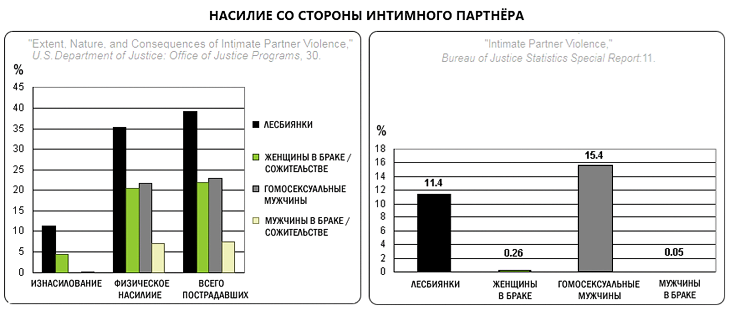
Cancer and obesity
Women who have never given birth are at a higher risk of cancer. Women's Health Authority (HHS) notesthat hormones released during pregnancy and breastfeeding protect women from breast cancer, uterine cancer and ovarian cancer. WSW are exposed to these forms of cancer to a greater extent, since they are less likely to become pregnant, and if it does occur, then the chances of it abortion higher. Research demonstrated link abortions with breast cancer and psychological disorders. Polycystic ovary syndrome, a risk factor for uterine cancer, much more often found among WSW.
Numerous studies [1, 2, 3, 4, 5, 6, 7, 8] showed that for lesbian and bisexual women are characteristic of much higher rates obesity (3 / 4 vs 1 / 2), which increases they have a risk cardiovascular disease, certain types of cancer, and early death. Growing amount of scientific evidence indicates the association of cardiovascular disease with an increased risk of certain types of dementia, including Alzheimer's disease and vascular dementia. Compared to other types of marital status, women in same-sex partnerships are a group with highest mortality rate, which in recent years continues to grow.
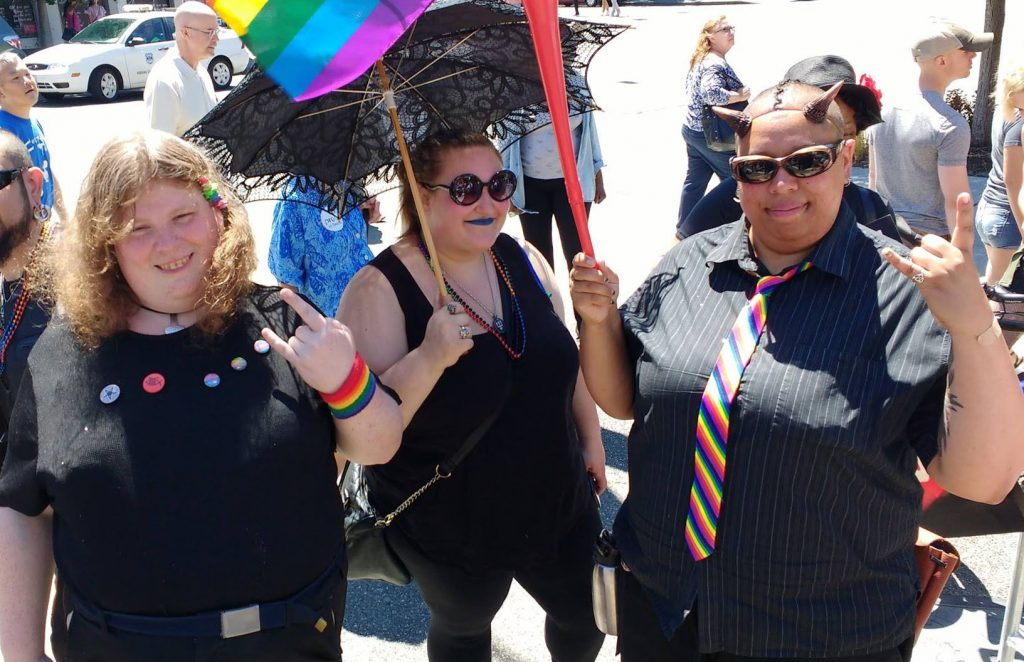
Possibility of change
It is important to know that for people experiencing an unwanted homosexual attraction, there is actually hope. Numerous cases of successful therapeutic correction not only of homosexual behavior, but also of attraction described in detail in professional literature. Edmund Bergler, who cured about 30 homosexual patients in 100 years of clinical practice, notesthat, in most cases, lesbianism, like male homosexuality, has an excellent prognosis for psychodynamic therapy. Report The National Association for the Study and Therapy of Homosexuality presents a thorough review of empirical data, clinical reports and scientific research from the end of the 19th century to the present, which convincingly prove that interested men and women can make the transition from homosexuality to heterosexuality.
The site Voice (s) of Hope collected about 80 video testimonies of women and men who broke with homosexuality and lead a full heterosexual lifestyle. And even if faith was the motivation for change in most cases, religion is not the main condition for change, although it is undoubtedly a valuable help, since it gives a person a clear guide and strengthens his will in opposing the dark side of his personality.
Based political ideology, Western medical institutions oppose the treatment of unwanted same-sex attraction under the pretext that it is "potentially harmful", but in fact, they deceive the publicwithout explaining that:
(1) All psychiatric services for all personal and interpersonal problems can be harmful;
(2) Responsible science has not yet shown whether the risk of harm in the treatment of an undesirable same-sex drive is greater, the same, or less than the risk of any other psychotherapy.
And while APA publicly condemns therapeutic attempts to reorient, in its internal highly specialized literatureintended for professionals reported following:
“Recent empirical evidence suggests that homosexual orientation can indeed be therapeutically altered in motivated clients, and that attempts at reorientation therapy do not produce emotional harm.”
There is no discovery in this: as far back as 1973 in a document proposing to exclude egosyntonic (i.e. acceptable for the patient) homosexuality from the list of mental disorders, APA noted the that “Modern treatment methods allow a significant part of homosexuals who want to change their orientation to do so”.
Research 2018 of the year showed that most of those who applied for group or professional help experienced significant heterosexual shifts in sex drive, identity, and behavior. In addition, they experienced marked decreases in suicidal ideation, depression, and substance abuse, as well as increased social functioning and self-esteem. Almost all the harmful effects were insignificant, and the positive and negative effects were comparable to those with conventional psychotherapy of other mental problems.
It should be noted that the problem of homosexual attraction is no different from any other therapeutic problem: “change” does not mean at all that the problem disappears once and for all. For example, if a person successfully got rid of depression, this does not mean that he will never have it again. Also, people who get rid of drug or alcohol addiction will face old temptations, but to a much lesser extent, and stumbling and sliding back is a matter of one wrong step.
The transition from homosexuality to heterosexuality should not be seen as a question of "either one or the other." There is a certain continuum - that is, a slow progressive decrease in homosexual tendencies and an increase in heterosexual qualities, the degree of manifestation of which varies widely. Many of those who got rid of homosexual addictions with the help of psychotherapy, regretted only that they had not done this before, because they were convinced that they could not or should not try to change.
Extra charges:
From Tomboys to Lesbians (J. Nicolosi) .pdf
In this interview, two women in a lesbian relationship talk about the reasons that led them on this path. Their narrative fully echoes the rich clinical experience detailed in the professional literature, which indicates that lesbianism is often based on severe trauma received from men. This trauma can manifest itself in paterophobia (fear of the father) and / or androphobia (fear of men in general). The fathers of women who later enter into homosexual relationships, often callous, abuse alcohol or resort to violence.
The American Psychological Association notes that the absence of one or both parents, mainly the parent of the same sex with the child, may be causally related to homosexual attraction. For girls, the death of the mother in childhood plays an important role in this. Such girls have an unmet need for custody and a desire to restore a fragile bond with their mother, whose prototype they are unconsciously looking for in another woman.
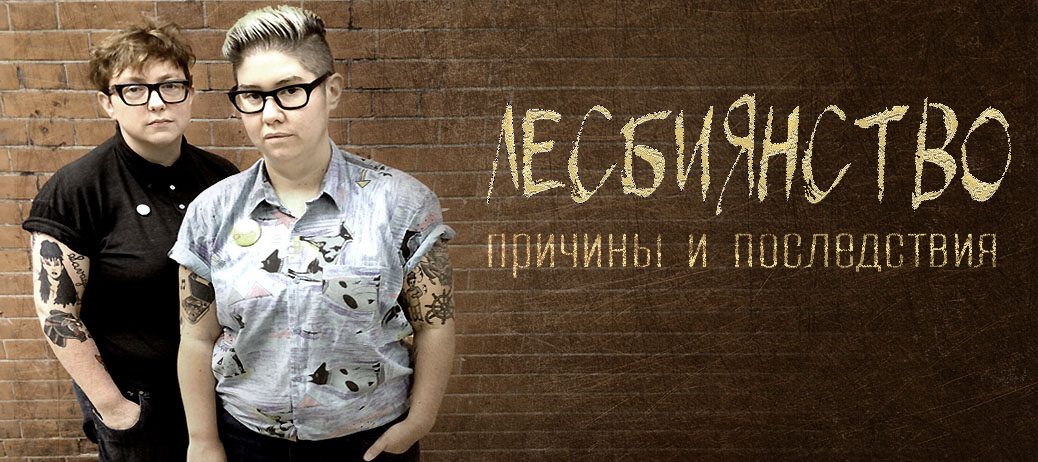
There are beautiful lesbians in life, the author of the article specifically found such terrible photos. Lesbians are ordinary women and they can be completely different as well as straight! Do you think heterosexuals look like Angelina Jolie all the time?
Club lesbian poets:

Beauties lol
Interestingly, do they know anything about makeup? No wonder they are lesbians
This is exactly what real lesbians look like, as shown in the article. You apparently read this article through your fingers. Homosexual behavior and homosexual attraction are not the same thing.
Why not first familiarize yourself with the content of the article before writing comments off topic? Everything is explained in it.
Yes, there are “fashionable” lesbians—teenage girls who experiment with their gender and declare themselves “lesbian” or “bi” more because of the current cultural trend than because of the damaged femininity that lies at the heart of lesbianism.
Until I was 20 years old I didn’t use makeup and dressed so that on the street I often heard “young man” addressing me. Closer to 25, she let go of her hair, began to competently use cosmetics and even wear dresses / skirts.
Gender dysphoria and sexual orientation are not the same thing!
You are a vile homophobic propaganda portal and will be blocked. Required.
Well said.
Cat de handicapați sunteți, dacă cine vă spune adevărul în față gata e homofob, sunteți cretini?! Asta e părerea autorului din sursele din care a extras, vă supăra adevărul? Atunci asta este, adevărul nu poate să fie inâbușit niciodată, aștept răspunsuri de genul “homofobule”
same cí věci.Homosexualita je zcela normální jev.Autorka je mimo
And who the pancake should shake, who meets with whom!
I know (or have come across in life) a LOT of lesbians with the appearance of almost models! I understand that the purpose of the article is anti-propaganda, and it’s also written so naively and stupidly (for the natives from the island). Instead of all this nonsense, let’s seriously understand the reasons and possibilities of “what to do”!
Here is another model for you:

Pretty guy)))
An ordinary obese woman over 40. Straight straight all the top models!
It is more correct to say not “straight”, but normal/healthy. The leskicon of sodomites is internally flawed.
In this case, the terminology “disease” is not appropriate. Homosexuality is a type of norm.
Fool, do you even understand the meaning of what you wrote? Anti-propaganda! Based on the term you use, you acknowledge that there is LGBT propaganda as a phenomenon. Is it naively silly written? Seriously? On the statistics and experiments of scientists?
You yourself are anti-propaganda. What exactly is wrong? Only poop know how to throw? Essentially, as usual, there is nothing to argue.
Only you are throwing poop here, dear. Her comment is more than appropriate.
To podrzuć nam kilka fotek tych lesbijek
And none of that detracts from what the article states.
How do you know those models aren't lesbians due to trauma? (In fact there is a beautiful Polish girl in a lesbian relationship with Taiwanese girl, both of whom seem to indicate a case of emotional copendence and a lack of parental affection and attention).
They literally (unbeknownst to them) repeated the reasons for their lesbianism from this article.
Also, as pointed out, a lot of young girls are having emotional support from female friends / associates confused with romantic / sexual attraction.
They're actually seeking out emotional attention; and in today's perverse society a lot of young girls are being goaded into turning emotional bonds with other girls into sexual relationships. This is especially prominent among girls hitting puberty, which results in them becoming sexually disoriented.
Heck, in the UK, they now say that only 1 in 2 young teens consider themselves to be thoroughly heterosexual. The YouGov report indicated that 23% of British people choose something other than 100% heterosexual - and the figure rises to 49% among 18-24 year olds.
This is awful, and you're seeing it more and more as especially young girls are roped into thinking they need to be bisexual or lesbian to fit in with their peers. Women are also more likely to acquiesce to peer pressure more than men, even if it's not something they inherently see as beneficial to them. Hence, you see a lot of young, fertile, beautiful women being chained into toxic lesbian relationships because the media told them that heterosexuality is a “social construct” and a compulsory element of a patriarchal hierarchy.
These poor young girls will be ruined almost for the rest of their lives unless they seek therapy ASAP, because otherwise they will simply become a statistic like the ones mentioned in the article above.
Horrible article
Horrible comment
It's a great article
What kind of wretched nonsense is written in my commentary e̶t̶o̶y̶ ̶s̶t̶a̶t̶e? O_O
Good article. Though the truth about homosexuality is written somewhere.
LGBT girls, come to your senses! You are living a fake life. Don't kid yourself that orientation can't be changed. Believe me, if you want to live truly, find true happiness and a full-fledged family, you can change and will be very happy in your new role - a woman in the full sense of the word.
God give you family happiness with a loving and beloved man!
Yeah. Islet of sanity.
fake life? It's quite the opposite, actually
The fact is that lately there are almost no men who love it…. Now you have to be with an ideal figure to please them, and you must cook and wash. Most people don't want to be in a relationship like a bondage.
Thus, you bring your slavery closer
Homosexuality is a kind of norm, it is not a disorder. There is no evidence to the contrary. Others are more than enough.
Homosexuality is by no means the norm, but a psychiatric disease, a disorder of human sexuality. He was removed from the list of psychiatric diagnoses strictly for political reasons related to the pressure of sadomites dissatisfied with the truth, which has nothing to do with medicine and real science. And to make people believe that homosexuality is normal, they are able only by force, which is clearly expressed in modern violent prohibitions in society. As they say, if you are not able to compete with the truth, silence it, which was done in Western society.
I'm lesbian, and I agree with the author. Most (but not all) lesbians are unsympathetic, afraid of men, unable to tolerate loneliness, have difficulty establishing long-term relationships, have increased anxiety, and have great difficulty in planning and making long-term plans. I don't agree that this is an easy fix. Maybe if you catch it in adolescence, you can correct it in some cases. But they don’t want to correct, they believe that the whole world is offending them, and if you change the attitude towards them, then everything will work out for them. But, alas, oh, mental health does not improve. It’s a pity that instead of competent psychological help, they are drawn into a community of essentially the same losers.
You are correct, you said everything. I also agree with you. We all need to be treated. You are such a great fellow. And it's hard for me to admit I'm a failure. You are probably already straight and married.
This is the thing I fear the most.
A lot of Gen Z kids being lured into the dangerous occult-like lifestyle of the Rainbow Reich and then being unable to escape from it in a healthy manner, or wasting away all their good years stuck in a trauma-inducing cycle of physical or emotional abuse.
It's scary to think about how many innocent kids will be lost to this LGBT pandemic.
Olga, have you yourself tried to change something in yourself and work on yourself, for example, become a heterosexual woman, have a husband, a family, and children? Or do you live by the principle of come what may and go with the flow?
I hate lesbians with passion.
You are correct, you said everything. I also agree with you. We all need to be treated. You are such a great fellow. And it's hard for me to admit I'm a failure. You must be straight and married already, Olga.
Let them treat you, and leave us healthy homosexual people alone.
I immediately remembered the comedy “They Will Cure Me too”, although the talk there was not about political lesbians as in this article
You didn’t bring up more than one argument to refute what was written in the article, which people from the “Science for Truth” group tried to refute with all their love and research, where they took into account research both older - before all this LGBT hype, and relatively new ones. They also added to Freud’s words, where he did not say a word about the fact that homosexuality is the absolute norm of human sexuality, but only said that it is the cause of delayed sexual development and education. So come on, Lizok, stop licking pussy and read professional sexology medicine of the early years, and not the bullshit written in Intrigue dating from Fomina’s couch expertise.
Of course, it's hard to admit that something went wrong at some stage, I understand perfectly well.
For my part, I’ll say – I’m bi. And I absolutely agree with the author about the psychological reasons for gayness. But I don’t agree that this is a disease, it needs to be treated, otherwise it’s screwed, etc. and that's all. Yes, I had big problems communicating with boys at school and some problems with my dad. But they are long in the past, I resolved them and forgot. There is a woman who I incredibly like as a person, she is tender and fragile and there is a subconscious desire to support her, protect her, intercede, protect her... I don’t know why. We have a deep relationship with a similar world view and hobbies. There is some sexual connotation, there is, but nothing more than it is still something spiritual and subtle and I, damn it, don’t understand why this is bad? If the Lord has provided it this way... I don’t think I’m doing anything wrong. Despite the fact that I plan to build a long-term romantic relationship with a guy one day, and sexual relationships too. But ONLY that same guy. I DO NOT experiment with my sexuality. I am very GLAD that I am bi, because the reality for me is different, much brighter and deeper.
In short, it just annoys me when the rainbow community is attacked. Let people love who they want to love and get on with your life. Just.with.your.life. If you don’t like them, don’t pay attention to them – it’s simple
Nastya! Please tell me you want to start a family, children and be a beloved wife in the full sense of the word and build a relationship with a man. The path of a woman after a man.
No, she obviously doesn't want to. Stop imposing your wives, children! Happiness is different for everyone.
great article dave! your wife mentioned it last week and we decided to check it out over family dinner tonight. I recently vaxxed my youngest Jude in fear he will be caught in the LGBT pandemic. if only my wife's lesbianism were caught in adolescence, we wouldn't be living a lie. I hate also being a gay man who was not treated efficiently because sometimes i still experience thoughts and fantasies which can be hard to control at times, especially while visiting.
it's just very Ugly and for them to adopt children that's just child abuse